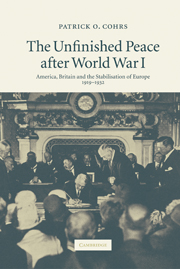Book contents
- Frontmatter
- Contents
- Acknowledgements
- List of abbreviations
- A note on the footnotes and bibliography
- Introduction
- Prologue
- 1 The wider challenges
- 2 Wilson, Lloyd George and the quest for a ‘peace to end all wars’
- 3 The ill-founded peace of 1919
- 4 The escalation of Europe's post-Versailles crisis, 1920–1923
- Part I The Anglo-American stabilisation of Europe, 1923–1924
- Part II Europe's nascent Pax Anglo-Americana, 1924–1925
- 11 The dawning of a Progressive Pax Americana in Europe?
- 12 Towards the Locarno pact
- 13 Regression?
- 14 Beyond irreconcilable differences?
- 15 The path to Locarno – and its transatlantic dimension
- 16 The second ‘real’ peace settlement after World War I
- Part III The unfinished transatlantic peace order: the system of London and Locarno, 1926–1929
- Epilogue
- Conclusion
- Map: Post-World War I Europe after the peace settlement of Versailles
- Bibliography
- Index
15 - The path to Locarno – and its transatlantic dimension
Published online by Cambridge University Press: 21 July 2009
- Frontmatter
- Contents
- Acknowledgements
- List of abbreviations
- A note on the footnotes and bibliography
- Introduction
- Prologue
- 1 The wider challenges
- 2 Wilson, Lloyd George and the quest for a ‘peace to end all wars’
- 3 The ill-founded peace of 1919
- 4 The escalation of Europe's post-Versailles crisis, 1920–1923
- Part I The Anglo-American stabilisation of Europe, 1923–1924
- Part II Europe's nascent Pax Anglo-Americana, 1924–1925
- 11 The dawning of a Progressive Pax Americana in Europe?
- 12 Towards the Locarno pact
- 13 Regression?
- 14 Beyond irreconcilable differences?
- 15 The path to Locarno – and its transatlantic dimension
- 16 The second ‘real’ peace settlement after World War I
- Part III The unfinished transatlantic peace order: the system of London and Locarno, 1926–1929
- Epilogue
- Conclusion
- Map: Post-World War I Europe after the peace settlement of Versailles
- Bibliography
- Index
Summary
As Chamberlain realised acutely in his consultations with Briand and diplomatic exchanges with Stresemann, each of them pursued specific interests and harboured different assumptions on what the Rhine pact was to achieve. In particular, each had his own rationale as to how dynamic or restrained a transformation of European politics the pact was to inaugurate, and what this portended for the order of 1919. In sum, Briand's main aim in the protracted negotiations with Britain and Germany between April and October 1925 remained to retain the upper hand in upholding the Versailles system, and French pre-eminence. He sought to decelerate and minimise inescapable changes; and he sought to conciliate and rein in a resurgent Germany, both through the pact and by closing ranks with Britain and the United States.
Stresemann's main rationale was in some ways the opposite: to accelerate Germany's return to the concert of great powers, which was to yield new possibilities for peaceful revisions. His was to be a path towards ‘liberating’ the Rhineland and forging new ground-rules for modifying the Versailles system politically, economically and, in a more distant future, territorially. He hoped to achieve all of this in a co-operative manner, recognising French, and British, interests while also enhancing Germany's standing with the US creditor.
Thus, both sides were beginning to pursue their aims on the shared assumption that neither could reach them without a consolidation of their bilateral relations, which had to go hand in hand with a consolidation of Germany's position in Europe.
- Type
- Chapter
- Information
- The Unfinished Peace after World War IAmerica, Britain and the Stabilisation of Europe, 1919–1932, pp. 237 - 258Publisher: Cambridge University PressPrint publication year: 2006



